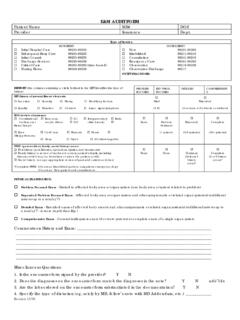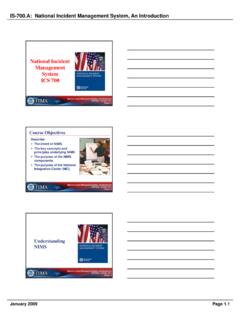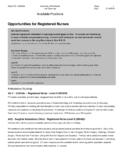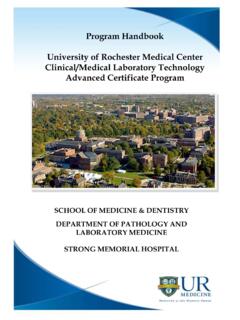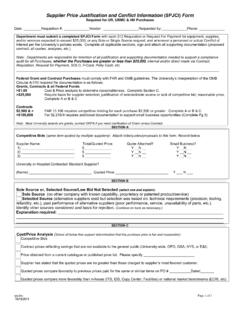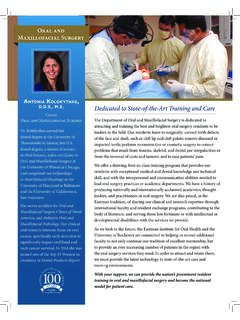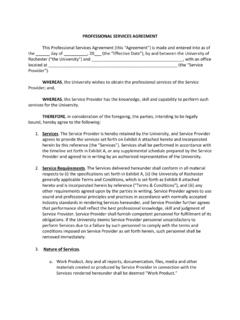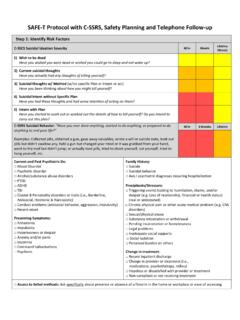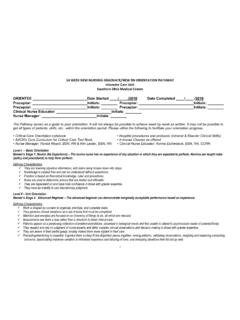Transcription of Disaster Triage Train-the-Trainer START/JUMPSTART
1 Disaster Triage train -the-TrainerSTART/JUMPSTARTF inger Lakes Regional Training CenterChristopher Tarantino MEP, CMCP, CHEC-IIIFLRTC InstructorAGENDA Housekeeping Sign in Restrooms emergency exits Mobile devices Introductions Presentation Scenario & Skills Train-the-Trainer Content Additional ResourcesIntroductions Christopher Tarantino, MEP CMCP CHEC-III CEO/Instructor Epicenter Media & Training Firefighter/EMT & Hazmat Tech/Rescue Specialist (Monroe County) Certified Hospital emergency Coordinator (Level III) Instructor +10yrs experience in emergency response & management Experience with major Disaster response, training/exercises, etc. at local, county, state and federal levels & trained in many types of Triage systems (SALT, MASS, start , SMART, ESI, etc.) Has taught healthcare, first responders and other public safety professionals in more than 30 different states in the Student Introductions: Name Agency/Organization Experience with Triage and/or Disaster responseObjectives: Define a Mass Casualty Incident and the unique challenges of an MCI Understand the differences between day-to-day Triage and Triage during an MCI Increase the region s healthcare providers awareness of Disaster triageWhat is the Goal of MCI management ?
2 GOAL:TO SAVE THE LARGEST NUMBER OF SURVIVORS FROM A MULTIPLE CASUALTY INCIDENTThe ProblemCasualtiesResourcesConsiderations During an MCI Response Supply vs. Demand Resource Allocation Coordination Medical management EthicsCasualtiesResourcesThe ObjectiveWhat Could Be an MCI For You? Transportation Accident Fire Hospital Overloading Hospital EvacuationFebruary 2008: 390 Pile UpJanuary 2005: 390 Bus Accident Sporting Event Hazmat Incident Loss of Power Severe WeatherWatkins Glen SpeedwayWhat Could Be an MCI For You? Managing Mass Casualty Incidents Would any of those situations lead to shortage of personnel & equipment resources? Would decisions and changes need to be made in how you do business? Altered Standards of Care PrioritiesHospital Considerations Transition from the EMS patient to hospital patient Dealing with self presenting patientsTransportation DistributionPatient transport - Oklahoma Bombing Private carEMSOn footOtherInjury prevention database, OK Dept of HealthPatient Transport - 29 US DisastersEMSP rivate carPoliceOtherOn footBus TaxiQuarantelli, Delivery of emergency Services in Disasters, Assumptions and Realities As bad as the scene was 20 minutes after the blast, it only got worse.
3 Patients who could self-evacuate generally had relatively minor injuries. They arrived on foot, by taxi and by motorcycle, and they were treated as they came in. But then the ambulances started to arrive with the most serious patients the burn By then, though, the operating rooms were completely full. They had to wait .Dr. Tjakra WibawaSanglah Trauma CenterBALI NIGHT CLUB BOMBINGO ctober 12, 2002 Incident Command SystemEmergency Triage SystemsMASS Move, Assess, Sort, Send ESI emergency Severity Index SALT Sort, Assess, Lifesaving Interventions, Treatment/Transport start /JumpSTARTD isaster Triage SystemsMASSESISALTSTART/ jumpstart Simple Triage and Rapid Treatment Types of Triage Primary On scene prior to movement or at hospital (self transports) Secondary Incident dependent, probably prior to or during transport or upon arrival to hospitalTriage Protocol ( start )
4 Triage CodingImmediate 1 Urgent 2 Delayed 3 Dead 0 REDY ellowGreenBlackColorPriority TreatmentPrimary TriageThe ScenePrimary TriageThe first attempt at balancing resources and casualties/injuredPRIORITY 3 Not injured or Walking wounded Have motor, respiratory, mental functionDELAYED ExamplePatient walks over to you andhas an obvious broken armRespirations are 22 Pulse is 124 (Radial)He is awake, alert, and cryingPrimary TriageDetermining whether there is an airway and breathingPrimary TriageIf breathing, at what rate & is it good enough?Primary TriageThey have an airway, are breathing. Are they circulating blood sufficiently?Circulatory TriageABCM ental StatusPRIORITY 1 Immediate Opening airway, starts to breathe Breathing is greater than 30 or less than 10 Delayed capillary refill time (> 2 seconds) Absent radial pulses Bleeding that needs to be controlled Does not follow instructionsExamplePatient has an open headWound, bleeding controlledRespirations are 16 Pulse is 88 (Radial)He is unconsciousPRIORITY 2 Urgent Did not move out, when asked Airway OK Breathing within 11 and 29 Capillary refill less than 2 seconds or radial pulses present Can follow instructions to move unaffected limbExamplePatient states he can tmove or feel his legsRespirations are 26 Pulse is 110 (Radial)
5 He is awake and orientedEXPECTANT/DEAD Still require resources Focus of care is comfort Psychologically most challenging for healthcare providersExamplesPatient gurgles but can tmaintain an open airwayand Is not breathing Weak Carotid PulseShe is unresponsiveSecondary Triage Generally used when there is an extended duration event After initial color coding Triage Healthcare professionals who respond to the scene or PH/Hospital response teams may be utilized to further determine who gets transported from scene firstSecondary TriagePediatric Triage Children are involved in mass casualty incidents The over prioritizing of children will take valuable resources away from more seriously injured adults Triage systems based on adult physiology will not provide accurate triageThe SMART Tape SMART Tag Triage SystemSMART Triage Pack Contents Dynamic Tags (20) Dead Tags (10) Pencils Cylume Sticks Patient Count Card/Protocol SMART Pediatric TapeScenario Practical ApplicationInstructionsIndividual patients will be shown on the screen (with signs/symptoms) SMART Triage important info (not all signs/symptoms are pertinent) initial Triage decision(s)Scenario #1An improvised explosive device is detonated at a large outdoor sporting event.
6 At least 50 people are confirmed injured. EMS is on scene, but patients begin to arrive at your hospital before and Tag the following #1 What are your immediate priorities?Who will conduct Triage ? Where?How do you expect these priorities and considerations to evolve as time progresses?Patient #1 ApneicPulse-lessMissing LUEP atient #1 ApneicPulse-lessMissing LUEP atient #2 Eviscerated bowelMultiple penetrating wounds to chest & headBrain matter exposedUnresponsive to tactile stimuliPatient #2 Eviscerated bowelMultiple penetrating wounds to chest & headBrain matter exposedUnresponsive to tactile stimuliPatient #3 Abd. Tenderness and minor penetrating traumaAmbulatingA & O x 3RR 24 Strong radial pulsePatient #3 Abd. Tenderness and minor penetrating traumaAmbulatingA & O x 3RR 24 Strong radial pulsePatient #4 Multiple penetrating injuries, blood in earsResponds only to painAirway clearRR 20 Strong Radial pulsePatient #4 Multiple penetrating injuries, blood in earsResponds only to painAirway clearRR 20 Strong Radial pulsePatient #5 Extremity fractures, blood in earsA & O x 3RR 26 Strong radial pulsePatient #5 Extremity fractures, blood in earsA & O x 3RR 26 Strong radial pulsePatient #6 Child, screamingMinor lacs, blood in earsRR 30 Moving all extremitiesPatient #6 Child, screamingMinor lacs, blood in earsRR 30 Moving all extremitiesPatient #7 Amputated fingers, head injuryA & O x 3 DizzyRR 24 Smells like beerPatient #7 Amputated fingers, head injuryA & O x 3 DizzyRR 24 Smells like beerPatient #8 Chest pain.
7 SOBNo trauma notedRR 34 ShallowWeak radial pulsePatient #8 Chest pain, SOBNo trauma notedRR 34 ShallowWeak radial pulsePatient #9 Blood in nose, mouth and earsNot breathingPatient #9 Blood in nose, mouth and earsNot breathingWhat would you do?Patient #9 Blood in nose, mouth and earsNot breathingRR 10 with manual openingPatient #10 Some penetrating traumaUnresponsiveApneicNo radial pulseCarotid 130/minPatient #10 Some penetrating traumaUnresponsiveApneicNo radial pulseCarotid 130/minPatient #11 Arterial bleed from legResponsive to painRR 34No radial pulseCarotid 130/minPatient #11 Arterial bleed from legResponsive to painRR 34No radial pulseCarotid 130/minPatient #12 Minor lacsCryingAmbulatoryRR 24 Patient #12 Minor lacsCryingAmbulatoryRR 24 Patient #13 Deviate tracheaRR 40 Weak radial pulse+JVDC yanosisPatient #13 Deviate tracheaRR 40 Weak radial pulse+JVDC yanosisPatient #14 Open fracture of RUENon-ambulatoryA & O x 3RR 26 Strong radial pulsePatient #14 Open fracture of RUENon-ambulatoryA & O x 3RR 26 Strong radial pulsePatient #15100% TBS burns (partial and full)
8 A & O x 2RR 36 CoughingStrong radial pulsePatient #15100% TBS burns (partial and full)A & O x 2RR 36 CoughingStrong radial pulsePatient #16CP, SOBS lurred speechR sided weaknessA & O x 1RR 24 Strong radial pulsePatient #16CP, SOBS lurred speechR sided weaknessA & O x 1RR 24 Strong radial pulsePatient #17 Avulsion RUEA rterial bleedA & O x 2RR 30 I m thirsty Patient #17 Avulsion RUEA rterial bleedA & O x 2RR 30 I m thirsty Patient #18 Open fractures BLEB lood in earsA & O x 3RR 28 Strong radial pulsePatient #18 Open fractures BLEB lood in earsA & O x 3RR 28 Strong radial pulsePatient #19 Hysterical, screamingBlood in earsA & O x 3RR 36 Strong radial pulsePatient #19 Hysterical, screamingBlood in earsA & O x 3RR 36 Strong radial pulsePatient #20 ChildCyanotic from nipple line upApneicPatient #20 ChildCyanotic from nipple line upApneicQuestions?
9 ?? Train-the-Trainer Set-up Appropriate classroom / lecture hall Materials & resources: PowerPoint slides & slide advancer Patient cards SMART Triage system, Triage protocol cards Other peripherals & learning aids Know your students: Background experience Role/responsibility for triageTrain-the-Trainer Content delivery Knowledge / Skills & Abilities / Attitudes Leave enough time for logistics, housekeeping, activities, etc. (plan & practice!) Training / Exercise planning: Don t just check the box start small & grow into larger, more complex training/exercises Wrap-up: Exams? Evaluations? Other requirements Certificates Classroom teardown & other logistics Increase familiarity/proficiency of the start and Jump start Triage methodologies Increase familiarity with the SMART Tag Triage System train with a standardized methodology and system Grow your organization s Triage & mass casualty response competencyRemember the goal ofDisaster Triage training Questions?
10 ??Thank You!Epicenter Media & TrainingInstructor: Christopher Tarantino, MEP CMCP Lakes Region Training CenterAnne D Angelo: Spezio: | EDUCATION OPPORTUNITIESV isit Our Website Triage Training Resources Preparedness & Response Tools/Resources Disaster Triag
